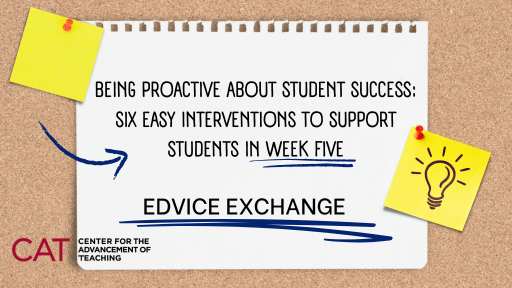Dana Dawson, PhD and Linda Hasunuma, PhD

It’s common for faculty members to use midterm exams or projects to assess student progress, however, for students who are struggling, a midterm check-in may come too late to effectively address challenges. In this post, we’ll talk about ways to check in with students earlier in the semester and what to do if students are missing classes and assignments or their work demonstrates a need for additional support.
Enter your Midterm Progress Ratings for Academic Progress
In spring 2024, Midterm Progress Ratings (MPRs) for undergraduate classes will be open from January 31, 2024 to March 11, 2024. This is three weeks earlier than in previous years so that instructors can provide targeted outreach to students who may need additional guidance or resources to support their learning and retention. It’s a good idea to check your rosters for students who have missed classes or assignments, or whose submitted work is not meeting a passing standard and enter progress ratings as early as possible. It won’t come as a surprise to faculty that missed classes and assignments in the first weeks of classes are a strong predictor of poor course outcomes, so the sooner these patterns are identified, the better.
Some advising units use MPRs to identify students who require additional outreach and support. Students are also notified if a professor has submitted an MPR. While this can be a helpful indicator to some students that they are at risk of not succeeding in the course, for others, a rating of “Unsatisfactory” can be discouraging, so we recommend reaching out to students who are identified as “Unsatisfactory” (more on that below). There is a helpful guide to completing MPRs available in TU Portal.
Reach Out to Students Whose Attendance, Course Engagement and/or Work on Assignments is Cause for Concern
If in the process of reviewing student performance and completing MPRs, you notice a student has not been regularly engaging with your course or is struggling with assignments, check in with the student. You might send an email using TUmail or the Canvas email function or have a brief chat with the student after class. You can also check the “People” function in Canvas to see how much time students have spent in the course and email them directly from there. Some faculty members schedule meetings with students around the quarter-semester mark, though the size or number of your classes may prohibit this option. If you have too many students to make bespoke outreach possible, Canvas’s “message students who” function can help.
Be sure to communicate to the student that you want them to succeed and that you’re there to help. Share information on resources such as the Student Success Center, Disability Resources Services, Cherry Pantry, and the Wellness Resource Center. If you want to learn more about available resources, the Dean of Students office has a “Red Folder” with advice on making appropriate referrals.Temple has also made new apps available to students who may need mental health counseling, such as TogetherAll and Welltrack Boost. Checking in with your students demonstrates your care and concern, which can also make a difference to a student who may be feeling overwhelmed or struggling.
Give a Word of Encouragement
This is the time in the semester when the full weight of their obligations begins to hit students. Assignment due dates start to amass. Midterm exams loom. A majority of Temple students hold at least one part-time job and many participate in extracurricular activities, some of which are required by their colleges. It’s a good time to remind our students that we see and appreciate their work and that we believe they can succeed. Some students may need more guidance about resources available to them for building their study skills, including note taking, time management, and mapping out their schedules with their various responsibilities outside of school; some may be managing challenges related to housing, food security, or other personal matters that may make it harder for them to manage coursework. We can be proactive and normalize help seeking by regularly reminding students about resources on campus during these stressful stages of the semester and ensuring we list available resources in our Canvas sites.
Use Informal Surveying or a Mid-Semester Instructional Diagnosis to Check In
While we collect student feedback at the end of the semester, at that point, it’s too late to change anything. Consider using an informal, anonymous survey that asks students what is most helping their learning and what is getting in the way of their learning. This can be done using a tool such as Google or Microsoft forms or simply by using index cards. Stephen Brookfield’s Critical Incident Questionnaire can also be a helpful tool for regular check-ins.
The CAT can also help! We invite you to schedule a Mid-Semester Instructional Diagnosis: a CAT staff person will visit your class for 35-40 minutes and (once you have left the room) gather consensus feedback from students on four questions relating to what you, and what they can do to improve their learning.
Encourage Students to Engage in Metacognitive Reflection
Invite students to reflect on their learning strategies and on what is working and what needs adjustment. Share strategies for studying or reading that encourage students to check in with themselves on their own understanding. While the semester is still relatively young, we have a window of opportunity to provide formative feedback that will motivate students and encourage them to take ownership of their learning.
As always, if you’d like assistance with supporting your students early in the semester, our faculty developers and educational technology specialists are ready to help. Make an appointment here or email a CAT staff member directly.